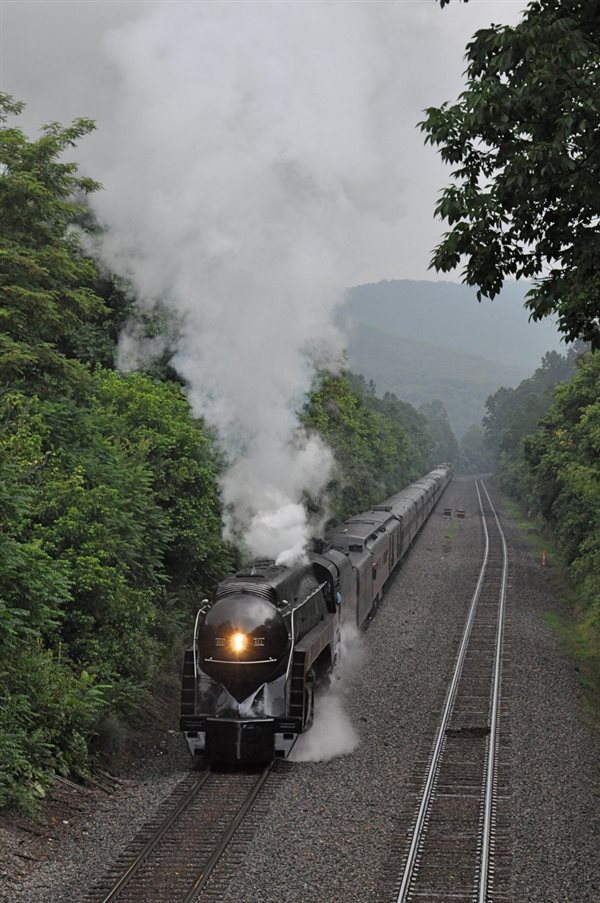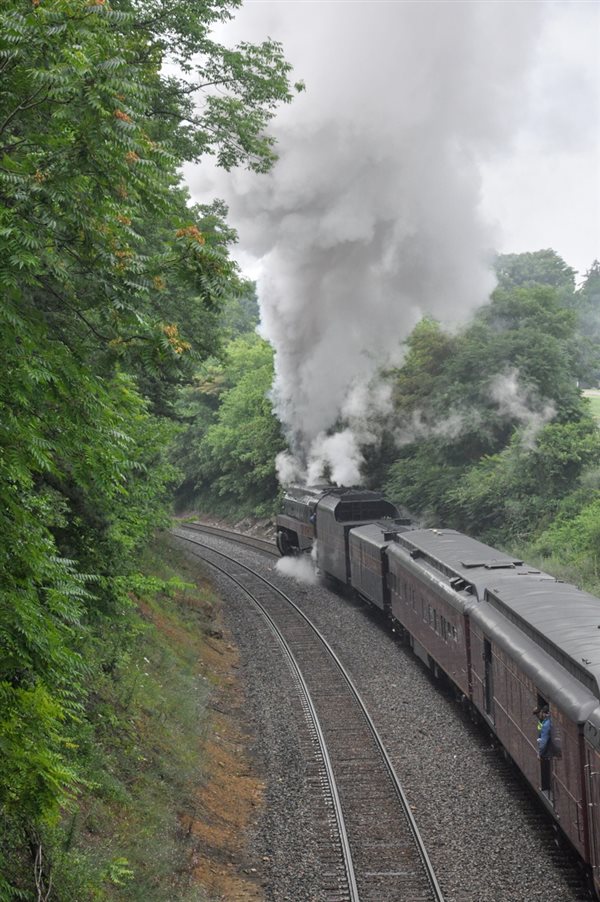Everyone loves a good Independence Day fireworks show. I actually didn’t have that pleasure this year. But, over the July 3-4-5 weekend, I witnessed one of the most powerful displays of fire and thunder I’ve ever seen.
Norfolk Southern’s 21st Century Steam road show came to Roanoke, Va., in a big way that first weekend in July. Each of the three days featured two excursion trips on the former Norfolk & Western main line, one east to Lynchburg via Blue Ridge Grade and one west to Walton via Christiansburg Hill. A total of six trips, each featuring two assaults on major grades, all powered by what is surely Roanoke’s most famous native son: N&W J-class 4-8-4 No. 611, built in the city at the company’s shops in 1950.
I’d been to Roanoke once before, in January 2004 for the opening of the wonderful O. Winston Link Museum in the old N&W passenger station. There wasn’t time then to explore the legendary grades on either side of town. And anyway, 611 and her onetime excursion running mate, N&W A-class 2-6-6-4 No. 1218, stood cold at the Virginia Museum of Transportation, to which they had been retired in 1994 when NS ended its steam program after nearly 30 years. The two engines had pride of place among VMT’s fine collection of rolling stock, but they hadn’t run in a decade, and it looked like they never would again.
Now, in 2015, NS was back in the excursion business, and I wasn’t going to miss 611’s big show in its hometown. With tickets for two trips in hand, and plans watch and photograph the other four, I hit the road for Roanoke.
I confess that 611 has never been one of my favorite excursion engines. I admired its elegant styling, respected the record of power and speed it and the other 13 J’s had written, and celebrated (and mourned) 611’s place in history as the third-to-last steam passenger locomotive built in America. Yet it didn’t grab me the way other engines had. For one thing, that streamlined shrouding, although a beautiful example of industrial design, had the effect of suppressing many of the qualities we love about steam locomotives.
More to the point, I’d never experienced 611 in full cry. I didn’t see it until after the 1986 derailment that prompted NS to restrict all steam movements to a sedate 40 mph. And I’d never seen the J in the kinds of challenging topography that it was built to tame. Knowledge of the 5,200 h.p., 110 mph capabilities of the J class infused 611’s jaunts across, say, northern Indiana with an air of restraint and moderation — like Ted Williams pushing a baby carriage.
My recent weekend with 611 was different. That 40 mph limit was still in place, but a consist of 21 cars and the grades of Blue Ridge and Christiansburg often conspired to hold 611 to half that or less. Time after time the great engine put on a ground-shaking, ear-shattering, cinder-pelting spectacle.
On Friday the 3rd, light rain challenged the ability of the Northern’s 70-inch drivers to hold the rail. In one of the most moving experiences of my railroad life, I stood with an ever-increasing crowd on the famous wooden bridge at the top of Blue Ridge. To the east, down toward Villamont, we could hear 611’s whistle booming for grade crossings, and its exhaust, slow and labored, then frenetic, then slower, again frenetic, and slower still . . .
When the 4-8-4 rounded the corner several hundred yards down the double track, it was no longer slipping, but it seemed to be barely moving. We watched transfixed as the engine marched resolutely toward us, smoke and steam rising high in the humid air. Closer . . . closer . . . not gaining much speed, but not losing any, either. Finally the exhaust was right before our faces, then beneath us, then POW-POW-POW-POW! — the drivers spun on the wet rail below the bridge. In an instant 611 regained its footing, and before three cars had passed the rhythm from the stack was noticeably increasing as the train crested the hill.
It was as dramatic a show of steam strength as I’ve ever seen, and it ensured for 611 a special place in my memory.

611 rounds the corner east of Blue Ridge summit with an excursion from Lynchburg on July 3.

611 marches resolutely toward the wooden bridge at the top of Blue Ridge.

611 explodes from under the bridge.

611 picks up speed as the first few cars crest the grade. Four photos, Robert S. McGonigal